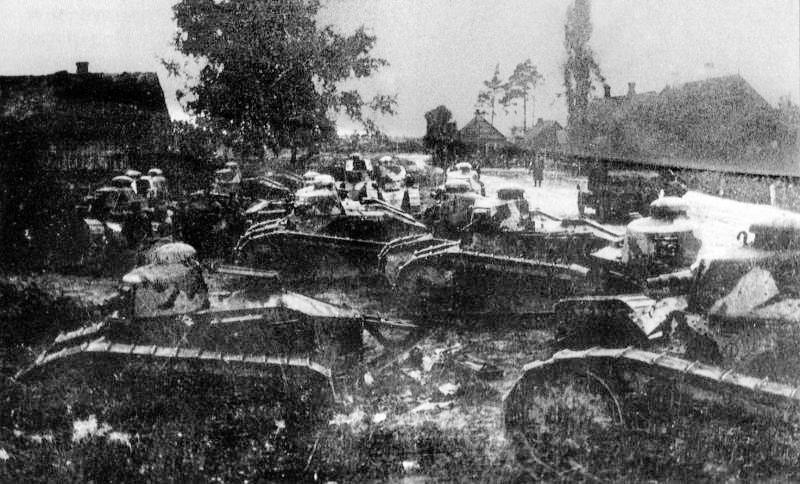Poles and Latvians together recaptured Daugavpils from Bolsheviks in 1920 and defended Latvia’s independence. It was then that the Polish army used tanks for the first time in battle.
In 1919-1920, the political situation in Central and Eastern Europe was extremely complicated. After the end of the First World War, the newly established Baltic States, including Latvia, struggled against the threat of Bolshevik Russia. Led by Lenin, the Bolsheviks aimed to spread the communist revolution to the West, which put Poland and its neighbours in immediate danger.
Polish-Latvian agreement
At this difficult time, Jozef Pilsudski, one of the leaders of the reborn Poland, sought allies among the neighbouring Baltic states. Latvia, under the leadership of Kārlis Ulmanis, was then in a particularly difficult situation – the eastern part of the country was occupied by the Bolsheviks, and German forces were threatening it from the south. Polish-Latvian cooperation thus became crucial for both nations facing a common enemy – Russia.
In 1919, Latgale, or the eastern part of Latvia, remained under the Latvian Soviet Socialist Republic, controlled by Bolshevik Russia. During this period, the independent Latvian Republic, strengthened after the successes at the Battle of Kiesia (1919) and the signing of the Armistice of Strazdumuiža, vigorously sought to remove the Bolsheviks from the area.
The Bolsheviks considered ceding Latgale to Latvia in exchange for a peaceful agreement. At this time, the situation on the front of the Polish-Bolshevik war was unstable. Polish General Rydz-Śmigły’s forces, which were part of the Lithuanian-Belarusian Front, approached Daugavpils, forcing the Bolsheviks to retreat beyond the Dvina River after a month of fighting.
In December 1919, the Latvian government, in alliance with Poland, decided to recapture Latgale militarily. For Poland, the removal of the Bolsheviks from Daugavpils was also strategically important.
On 3 December a joint planned offensive was agreed between Poland and Latvia. The main objective of this operation was to capture Daugavpils, which was strategically important for shortening the eastern front and strengthening the Polish left wing against the allied Latvian army.
Time for the battle
The date for the attack was set for 3 January 1920. On 30 December, a military agreement between Poland and Latvia was signed in Riga, establishing that 30,000 Polish and 10,000 Latvian soldiers would take part in the fighting, with the controlled areas coming under Latvian administration. Support was also to be provided by the 2nd Tank Company from the 1st Tank Regiment, with about 25 tanks.
Opposing the Polish-Latvian army was part of the 15th Red Army, numbering about 27,000 men and equipped with 180 guns.
The Poles and Latvians had a significant numerical advantage over the Bolshevik forces, with more guns and machine guns at their disposal. Latvian units, including the Latgalian Partisan Regiment, the 8th Dyneburg and 7th Siguldz Infantry Regiments, together with artillery support, occupied the northern section of the front.
General Edward Rydz-Smigly took command of the Polish-Latvian army. Despite extremely low temperatures and heavy snowfall, the Polish troops proceeded. The 5th Legion Infantry Regiment crossed the Daugava River and, after fierce fighting, took Mozuļi, continuing the assault towards Vyški. The 3rd Battalion of the 1st Infantry Regiment also crossed the Dvina River, reaching Zaļā Pušča. The 7th Infantry Regiment of the 1st Division, after breaking through enemy resistance, reached Bramaniški.
Daugavpils liberated
By 2 p.m. on January 3, Polish troops (1st and 2nd Battalion of the 1st Legion Infantry Regiment) had captured Daugavpils, breaking through strong Bolshevik resistance. Bolshevik losses were significant, although exact figures are not known. Polish and Latvian forces seized military equipment, including howitzers and weapons supplies.
The Red Army units that managed to withdraw from Daugavpils headed for Vyški. On 4 January, Polish and Latvian forces struck Vyški together, where there was fighting at the railway station, which was successfully captured.
On 7 and 8 January, Red Army units made several attempts to retake the railway station in Vyški, which were repulsed by Polish troops, albeit with difficulty. The advantage of the Latvian troops over the Bolshevik units was almost double, despite the fact that the Bolsheviks had a clear advantage in artillery. Their position also enabled them to regroup their forces efficiently due to their access to railway lines.
They defended Latvian independence
After the main battle action at Daugavpils was over, military operations spread to other areas of Latgale. Polish and Latvian troops continued their advance, taking key positions and driving out Bolshevik forces. The fighting continued until 25 January.
On 30 January 1920, after a month of secret negotiations, Bolshevik Russia and Latvia concluded an armistice, leading to a cessation of hostilities in early February.
The Poles and Latvians succeeded in defending the independence of the Latvian state. The Polish army, thanks to this victory, shortened its front in view of the upcoming next confrontation with Bolshevik Russia.
The Poles used tanks for the first time in these battles. A total of 25 Renault FT-17 tanks from the 1st Tank Regiment participated in the armed confrontation. The Bolsheviks had never encountered such forces before and avoided fighting with Polish tanks.





